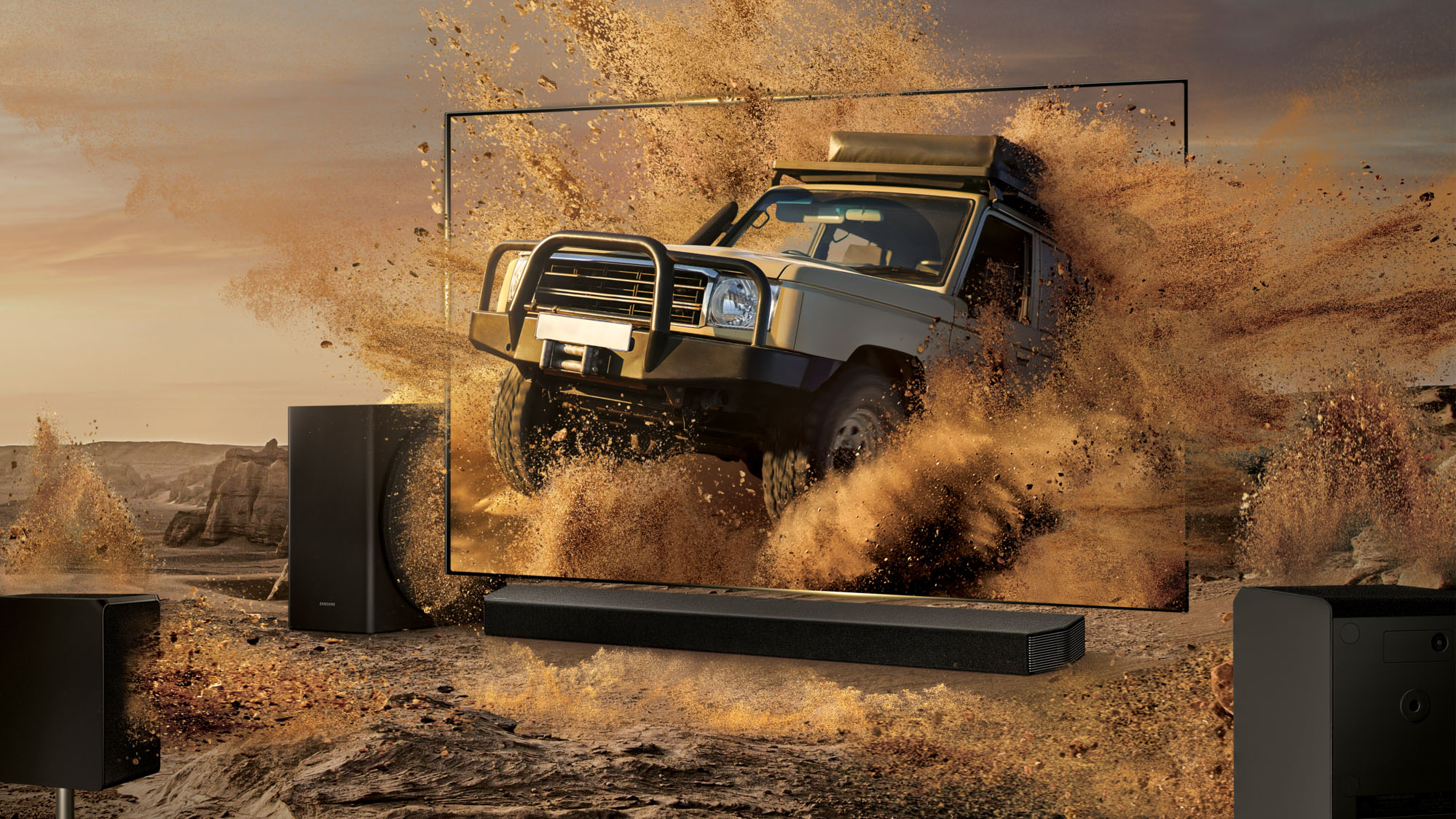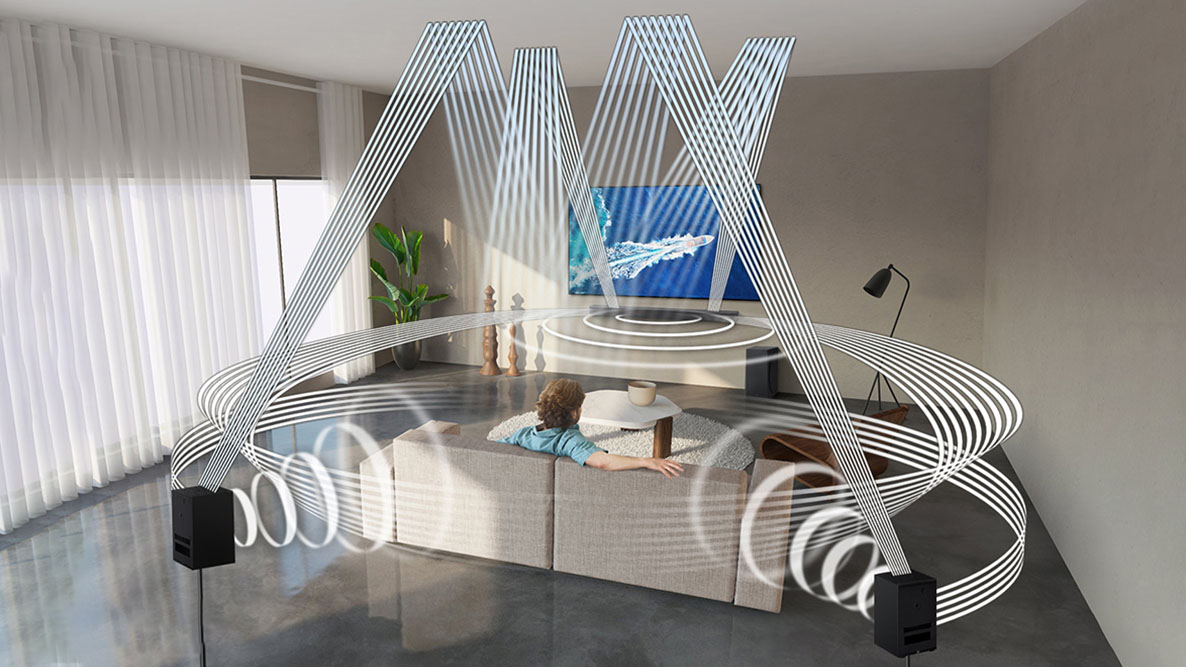Is your soundbar faking it? Don't settle: Samsung's Q-Series delivers the real deal
Don't put up with counterfeit surround from your soundbar – Samsung's HW-Q950A gives you true audio immersion.

All hail the modern soundbar, which has saved countless homes from the perils of trailing wires and speakers all round the room, as epitomised by the home theatre surround systems of the 1980s and 1990s.
Not too many years ago, the all-conquering soundbar arrived, offering one neat long speaker enclosure beneath your TV to replace a whole room of equipment. It was neat. With the addition of a wireless subwoofer it could sound huge. What wasn't to like?
But could the soundbar really do surround sound? In the early days, when replacing those multiple speakers, some daft claims were made, invariably involving the word 'virtual'. As soundbars have developed further over the years, fierce competition among brands has led to more spurious claims for soundbars than perhaps any other line of product. 'Virtual surround' is the common claim; 'virtual' meaning 'almost', 'nearly', but not really: a surround effect created by software processing that tries to fool the brain into believing sound is coming from speakers that don’t physically exist.
Does it work? Almost universally the answer is 'no', or not much, while the processing used to attempt the feat can be highly destructive to the sound quality. Here at TechRadar, we've heard hundreds of soundbars, from budget to extreme, and never has virtual surround truly seemed to come from behind.

How many drivers?
So how do you know if a soundbar is faking it? The simple answer is to count the drivers, and check how the power ratings are described. A great many soundbars operate in stereo, or 2.1 with a subwoofer, or 3.1 with an additional centre channel to support dialogue. The specifications often list two or three channels of power, two or three sets of drivers. Yet we’ve seen stereo soundbars claim to deliver 5.1.2channel sound – that’s full surround sound plus height. It’s nonsense! It’s 'virtual'. Sometimes these can be very nice sounding bars, but their marketers feel obliged to make outrageous claims in order to outflank their competitors.
One soundbar system which initially appears to make outrageous claims is Samsung’s latest HW-Q950A. It's said to deliver 11.1.4 channels – that’s 11 audio channels on the floor and four more delivering height information for Atmos and DTS:X soundtracks.
Impossible, surely? Yet Samsung’s claim is 100% genuine. Every channel gets its own driver, its own signal, and its own power. For once, this is a soundbar which absolutely isn't faking it.

Genuine, real surround sound
Samsung’s main trick to achieve this true immersion is obvious – the Q950A comes with not only a wireless subwoofer but also two wireless rear speakers. Each rear speaker has three drivers, delivering rear surround forward, plus wide surround to the side, and rear height channels from an angled upward-firing driver on the top of each unit. So that’s real surround and real height from the upward-firing drivers.
Meanwhile the bar at the front has three channels facing forward, four shooting from the sides, and two more height speakers on top. So 15 channels of sound in all, as advertised, plus the supportive 0.1 from the wireless subwoofer.
That's more than enough to support genuine Dolby Atmos delivery. Again, lesser soundbars often claim 'Atmos-compatibility' without attempting the height information which differentiates Atmos from lesser Dolby formats.
Compatibility does not mean delivery – but on Samsung's 11.1.4 Q950A soundbar, it most certainly does, and DTS:X too.¹

Ready to connect, adapt and even listen
On top of the additional channel count, Samsung has enhanced the latest Q950A’s connectivity, and added new features. With HDMI eARC, the soundbar can now receive surround sound down the HDMI connection to your TV, getting Atmos and other multichannel soundtracks from TV apps such as Netflix, Disney+ and Stan. There's SpaceFit Sound, which assesses your room and optimises sound levels accordingly.²
The Q950A supports multiple voice assistants, including Alexa and Bixby.³ And if used with some Samsung TVs – including the latest Neo QLED models – the soundbar can activate 'Q Symphony', making use of the TV's speakers as well as its own.⁴
So when considering a soundbar, learn to spot the fakes, and avoid the 'virtual'. There’s no shortcut to a truly immersive experience, no substitute for physical rear speakers, for separate channels, for genuine drivers. And Samsung's Q950A is loaded with them.
For more information on the HW-Q950A including stockists, please visit the official Samsung Q-Series page.
¹ Source content must be Dolby Atmos® or DTS:X enabled for Dolby ATMOS® or DTS:X playback. Sound effect may vary depending on environmental characteristics (including ceiling).
² SpaceFit Sound is compatible with 2021 QLED Q70A TVs and above. Sound effect and performance may vary depending on environmental characteristics (including ceiling).
³ SmartThings is compatible with selected devices. Please see https://www.samsung.com/au/smartthings/. Each device must be connected to Wi-Fi or other wireless network. Must download and install the SmartThings app. Voice commands recognise English, French, Spanish, German, Italian, Chinese and Korean. Not all accents, dialects and expressions recognised. Amazon, Alexa and all related logos are trademarks of Amazon.com, Inc. or its affiliates.
⁴ Samsung Q-Symphony is compatible with all 2021 Neo QLED, QLED & AU8000 Samsung TVs and 2020 Samsung QLED Q80T TV with Object Tracking Sound and above. Sound effect may vary depending on environmental characteristics (including ceiling).
Sign up for breaking news, reviews, opinion, top tech deals, and more.